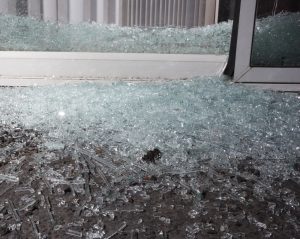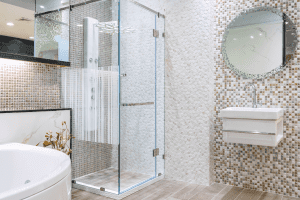Fiberglass provides both security and durability that last half a lifetime. So it no longer comes as a surprise if more homeowners are favoring it over wood doors. These selling points, however, sometimes make people wonder if drilling holes in the fiberglass door is possible. If so, how would you do it to avoid chipping and cracking? We did some research and found the answers to these pressing questions.
You can drill holes in fiberglass doors, just like wood. But it will take a little more effort and precautionary measures. The process will slightly differ if the fiberglass door is gel-coated or not. In general, the drilling process involves the following:
- Marking the part you will drill on and placing a masking tape on top of it to avoid chipping.
- Covering the drill with masking tape until only 1/2 inch of the tip shows to avoid creating a hole through the other side of the door.
- Drilling the door slowly by using slow rotational speed and increasing it as you go deeper through the door.
These steps may seem easy, but applying them is a different story. Keep reading as we provide you easy-to-follow guides in this blog, so you can safely drill holes into your fiberglass door.

How to drill holes into a fiberglass door?
Before we explore all the different steps, we need you to remember that fiberglass is made of microscopic materials. A fact sheet created by the Illinois Department of Public Health detailed that when fiberglass is drilled or sand, small or fiber particles can enter the skin pores, eyes, nose, and mouth that may result in detrimental health side effects.
As such, we advise you to equip yourself with the tools and protective gears below before you start drilling:
- Eye goggles
- Pants and long-sleeve
- Face masks
- Gloves
Also, make sure that no one except your helper is around to avoid respiratory accidents due to glass splinters and fibers.
Your safety when working with fiberglass is now taken care of. Let’s now discuss the drilling processes for non-gel-coated and gel-coated fiberglass doors.
Drilling Non-Gel Coated Fiberglass Door
- Precisely put a mark on the area where you want to drill a hole using a pencil.
- If you’re trying to make a considerably sized hole, slightly hammer a nail on the pencil mark to form a small indention on the fiberglass. This will ensure that the drill will not slide off course.
- Get steel brad-point boring bits and insert them on your drill.
- Point the drill on the pencil mark and turn the drill on with the lowest speed possible.
- Drill on the pencil mark slowly. As you progress, slowly increase the rotational speed of the drill until you reach the desired depth of the hole.
Drilling Gel-Coated Fiberglass Door
1. Follow the first two steps in drilling a non-gel-coated fiberglass door. If you plan to create a peephole, use a tape measure for accurate marking. Otherwise, wrap the boring bit until only 1/2 inch appears.
2. Cover the marking on the door with masking tape. You must cover the area you want to drill to prevent injuries from splinters and chipping, which is common when drilling or cutting gel-coated fiberglass.
3. Using a high-speed steel drill bit, start drilling on the door with the lowest rotational speed possible. Gradually increase the speed as you go deeper and stop the rotation halfway.
4. Flip the door and begin drilling again. This will prevent the fiberglass from cracking or chipping from the inside due to the centrifugal force when you bore through from just one side of the door.
5. Finalize the drilling process by countersinking the hole from end to end.
When you’re done drilling, you can immediately start inserting screws for your curtain rods using an electric screwdriver, provided that the drill hole is 1/16 smaller than the screw.
Are fiberglass doors solid or hollow?

As you may have noticed, drilling a fiberglass door needs proper maneuvering because of its composition.
Fiberglass doors are completely solid, not hollow. This type of door is the result of the compression of various materials and natural minerals, which makes them composites. Thus, fiberglass doors offer many benefits that include resistance to the elements, dents, the negative effects of moisture, as well as thermal regulation.
Do you need a special drill bit for fiberglass?
The solid core of fiberglass doors is what makes them a lot stronger than wood. Thus, you need a special drill bit when trying to drill through it.
According to Lowe's, high-speed steel (HSS) drill bits are the most ideal bits to use on fiberglass as they create less friction than regular steel bits, which can chip the fiberglass even with careful movements.
Using an HSS bit enables you to drill through the fiberglass with less effort but with much better and more precise results.
Another long-lasting drill bit specialized for fiberglass door drilling is a titanium-coated drill bit. If you have money to spare and want to ensure finer drill holes, you won’t go wrong with this type of bit that can last six times longer than other bits. It’s able to minimize friction, vibration, and heat when drilling. Thus, the possibility of chipping is further reduced, and rough edges become minimal.
How do you fill screw holes in a fiberglass door?
Nevertheless, whichever drill bit you choose, the result will always be an unappealing hole after removing a screw. Fortunately, you can patch these holes up with a specialized fiber-infused filler mixture that's available in your local home improvement store.
To fill the screw holes, you will need the items below:
- Latex gloves
- Soft cloths
- Sandpaper
- Putty knife
- Face mask
- Fiberglass filler
Here are the steps when filling screw holes on a fiberglass door:
1. Put on your protective gear, and start with cleaning the hole using a soft cloth. Then, sand the surrounding space.
2. Create a balanced, paste-like mixture of filler.
3. With the putty knife, scoop a generous amount of the mixture and fill the hole with it. Spread the excess around the surrounding area.
4. Let the filler dry and then smoothen it by sanding the surface.
What's the best way to hang things on a fiberglass door?
Hanging more accessories on your fiberglass door can be best accomplished by placing hooks inside the door. You simply use the appropriate drilling method for the type of fiberglass door you have, then insert a hook in the hole.
But if you don’t want to be putting holes and patching up the magnificent finish of your fiberglass door, there are three no-fail alternatives you can try, which you can find below:
Over-The-Door Hanger
Usually made of metal, over-the-door hooks or hangers come in a long-flat strip of metal that’s shaped like a capital letter A or an inverted letter U. You can conveniently insert and hang it on top of your fiberglass door without the need of a fastener.
The best part? They come in different colors and varieties that you can match with the finish or color of your door. And they may even be adjustable with a metal bracket to make them perfectly snuggle the fiberglass door, so you don’t have to worry about it falling.
Suction Hooks
Another good alternative for drilled hooks and screws is suction hooks. Since fiberglass doors aren’t grainy like wood, the suction hook can powerfully stick itself on the door. But the suction-cup base is especially effective when stuck on pure glass.
Magnetic Hooks
Lastly, you can make use of magnetic hooks that negate the issues of suction and over-the-door hooks. You can't attach the magnets on your own. You'll need extra hands to hold the other pair on the other side of the door to attach this magnetic hook.
The bottom line
Putting additional security locks, creating a peephole, and inserting hooks are hard when working with a fiberglass door. But they aren’t impossible. By using a specialized drill bit and applying the appropriate methods, you can start inserting screws on your fiberglass doors in no time. And if you don’t like seeing boreholes on your fiberglass, you can try using magnetic, suction, and over-the-door hooks to hang your curtains and other accessories.



